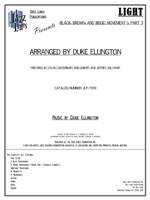BLACK, BROWN, AND BEIGE - MOVEMENT 1, PART 3: LIGHT
Arranged by Duke Ellington, Prepared by Dylan Canterbury, Rob DuBoff, and Jeffrey Sultanof

Cat #: JLP-7359
$75.00This item usually ships within 1 business day.
Questions?
Please call +1-518-587-1102 or email us.
Edition: Jazz Big Band Arrangement
Description: Swing - Advanced
Publisher: Jazz Lines Publications
It seems fitting that the third part of the first movement of "Black, Brown, and Beige," "Light," serves as somewhat of a recap of the first two parts. Throughout the piece, there are several references to both "Black" and "Come Sunday" passed throughout the band. Thankfully, Ellington's masterfully creative orchestrations prevent this section from sounding derivative or repetitive.
Coming out of the previous movement, Shorty Baker's trumpet performs a slowly ascending diminished fanfare out of time before playing a brief pickup figure to signal in the full band at measure 5. Some brief call and response figures between Baker and the ensemble lead into a variant on one of the major riffs from "Black" before a new melody is introduced at measure 21. Over top of this melodic statement is another reference to "Black," played by the plunger muted cornet of Rex Stewart.
The saxophones largely take center stage beginning at measure 37, with the brass providing some powerful background figures upon their re-entrance 8 bars later. A final descending ensemble figure leads into a lengthy written bass solo (played originally by Junior Raglin) from measure 61 to measure 81. The ensemble must remain underneath the soloist at all time while still maintaining an appropriate level of energy.
Upon the conclusion of the bass solo, the saxophone section takes center stage once again until measure 94, with a four bar trumpet fanfare breaking things up for just a moment. A sizeable portion of the section that follows is a call-back to "Come Sunday," beginning first in the saxes at measure 98, but eventually being passed off to Lawrence Brown's trombone. The rest of the ensemble figures during this section (most notably the sudden dip in tempo at measure 124) should be thought of mostly as framing devices for the trombone soloist.
The two movements finally come together at measure 140, with the trumpets playing the introductory fanfare from "Black" while the trombones (minus an improvising Brown) play the main melody from "Come Sunday." The arrangement sees a brief uptick in volatility at measure 156 with a sharply articulated trumpet fanfare giving way to a genteel saxophone ensemble that seemingly serves as the movement's lovely end.
Instead, Ellington pulls one last trick out of his sleeve with a sudden leap in tempo at measure 170. This final salvo contains several references to "Black," but also contains a fair amount of original content. At times, the music can seem somewhat reminiscent of the kind of music played during curtain calls for a musical. There should be an unquestionable raucousness in the ensemble, perhaps best personified by the relentless plunger muted trumpets. Just as things seem to be ready to spiral completely out of control, however, the arrangement catches itself and brings the full ensemble together for one final chord, followed by a quick punctuation to bring the first movement to a thrilling conclusion.
"Light" starts at 15:20 in the below clip.
2 Alto Saxophones
2 Tenor Saxophones (Tenor Sax 1 Doubles Clarinet)
Baritone Saxophone
4 Trumpets
3 Trombones
Guitar
Piano
Bass
Drums
Trumpet 2: Bb5
Trumpet 4: C6
Trombone 1: D5







![MOOCHE, THE [DOWNLOAD]](https://www.ejazzlines.com/wp-images/product/thumbnail/28046-s.jpg)

